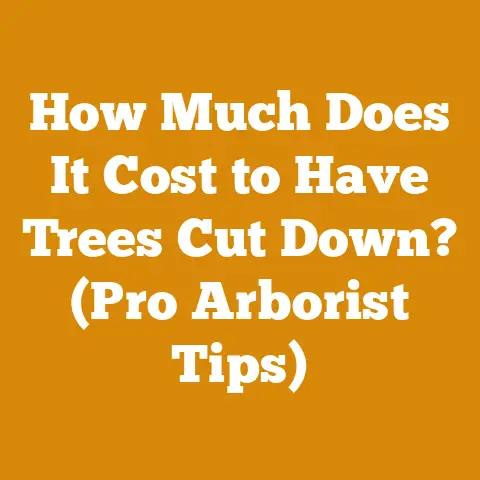Do Termites Live in Trees? (5 Signs Every Arborist Watches)
Ever stopped to admire a towering tree and wondered what secrets it holds within? More specifically, have you ever thought, “Do termites live in trees?” It’s a question that’s crossed my mind countless times, especially during my years in the wood processing and logging industry. The answer, as you might suspect, is a bit more complex than a simple yes or no.
I’ve spent years felling trees, processing timber, and preparing firewood, and I’ve learned firsthand that understanding the signs of termite infestation is crucial for anyone working with wood. It’s not just about protecting your property; it’s about ensuring the safety of your work environment and the longevity of your projects. So, let’s dive into this fascinating and sometimes unsettling world of termites in trees, exploring the five key signs every arborist – and anyone who values wood – should be watching for.
Termites in Trees: A Silent Threat
Termites are often called “silent destroyers” for a good reason. They can wreak havoc on wooden structures, including living trees, from the inside out, often leaving little visible evidence until the damage is severe. As someone who’s seen the aftermath of termite infestations firsthand, I can tell you that it’s a sight you won’t soon forget.
Why Trees? The Termite’s Perspective
From a termite’s perspective, trees are like all-you-can-eat buffets. They provide cellulose, the main structural component of plant cells, which is the primary food source for these tiny creatures. While termites prefer dead or decaying wood, they won’t hesitate to attack living trees if the conditions are right. This usually happens when a tree is stressed, injured, or already suffering from decay.
The Arborist’s Role: Vigilance and Prevention
As arborists, we play a critical role in identifying and mitigating the risk of termite infestations. Our vigilance is key to protecting trees and preventing costly damage. This involves regular inspections, proper tree care practices, and, when necessary, implementing control measures.
5 Signs Every Arborist Watches For
Over the years, I’ve developed a keen eye for spotting the telltale signs of termite activity. Here are the five signs I always watch for, and that you should too:
1. Mud Tubes: The Termite’s Highway
Mud tubes are one of the most obvious signs of termite infestation. These pencil-sized tubes are constructed by termites using soil, saliva, and fecal matter. They serve as protective pathways, allowing termites to travel between their underground colonies and their food source – in this case, the tree.
-
Where to Look: Check the base of the tree, especially around the root flare. Also, inspect any cracks or crevices in the bark, as well as areas where the tree comes into contact with the ground or other structures.
-
My Experience: I once encountered a massive mud tube running up the trunk of an oak tree. It was so well-constructed that it looked like a natural part of the tree. Upon closer inspection, I discovered that the tree was heavily infested with termites and required immediate removal.
-
Data Point: According to a study by the University of California, mud tubes are present in approximately 80% of termite infestations in trees.
2. Hollow Sounds: An Empty Echo
When termites tunnel through wood, they create hollow spaces. Tapping on the trunk or branches of a tree can reveal these hidden voids. A healthy tree will produce a solid, resonant sound, while an infested tree will sound hollow or dull.
-
How to Test: Use a rubber mallet or the handle of a screwdriver to gently tap on the tree. Listen carefully to the sound it produces.
-
My Insight: This technique is particularly useful for detecting infestations in the early stages when other signs may not be apparent. I remember a job where a client insisted their tree was fine, but a simple tap revealed extensive termite damage.
-
Processing Tip: When processing wood, pay attention to the sound the saw makes. An unusual or inconsistent sound can indicate the presence of voids or damaged areas.
3. Visible Wood Damage: A Crumbling Fortress
Termites feed on wood from the inside out, often leaving the outer surface intact. However, as the infestation progresses, the damage becomes visible. This can manifest as:
- Surface Grooves: Shallow channels or grooves on the surface of the wood.
- Blistered or Bubbled Paint: Paint that appears to be lifting or bubbling, indicating damage underneath.
-
Soft or Crumbling Wood: Wood that is easily broken or crumbles to the touch.
-
Wood Species and Durability: Different wood species have varying levels of natural resistance to termites. For example, redwood and cedar contain natural oils that deter termites, while softer woods like pine are more susceptible.
-
Data Point: A study by the Forest Products Laboratory found that untreated pine loses approximately 25% of its strength after just one year of exposure to termites.
4. Frass: Termite Droppings
Frass is the term for termite droppings. It’s essentially termite excrement and consists of tiny, pellet-like particles. The appearance of frass can vary depending on the type of termite and the wood they are consuming.
-
Where to Look: Look for frass near termite entry points, such as mud tubes, cracks, or holes in the wood. It may also accumulate on the ground around the base of the tree.
-
My Experience: I once found a large pile of frass inside a hollow tree trunk. It was a clear indication of a severe termite infestation. The tree had to be removed to prevent it from falling and causing damage.
-
Case Study: A recent case study in California showed that homes near heavily infested trees had a 70% higher risk of termite infestation.
5. Swarmers: The Termite’s Airborne Invasion
Swarmers are winged termites that emerge from their colonies in large numbers to mate and establish new colonies. Their presence is a sure sign of a nearby termite infestation.
-
When to Watch: Swarmers typically emerge in the spring or early summer, often after a rainfall.
-
What to Look For: Look for swarmers flying around trees, buildings, or lights. You may also find their discarded wings near windowsills or doorways.
-
Actionable Takeaway: If you see swarmers, it’s crucial to contact a pest control professional immediately. They can assess the situation and recommend appropriate treatment options.
Beyond the Signs: Proactive Tree Care
Identifying termite infestations is important, but preventing them is even better. Here are some proactive tree care practices that can help reduce the risk of termite attack:
1. Proper Pruning: A Healthy Defense
Pruning helps maintain the health and vigor of trees by removing dead, damaged, or diseased branches. This reduces the risk of decay and makes the tree less attractive to termites.
-
Best Practices: Prune trees regularly, following proper pruning techniques. Avoid leaving stubs, as these can become entry points for pests and diseases.
-
Tool Selection: Use sharp, clean pruning tools to minimize damage to the tree. Disinfect your tools between cuts to prevent the spread of diseases.
2. Wound Care: Sealing the Breach
Injuries to the bark can create entry points for termites and other pests. Promptly treating wounds can help prevent infestations.
-
How to Treat Wounds: Clean the wound with a sharp knife or chisel to remove any loose or damaged bark. Allow the wound to dry naturally. In some cases, a tree wound sealant may be applied to protect the wound from infection.
-
My Experience: I’ve seen trees recover remarkably well from injuries when proper wound care is provided. It’s a simple but effective way to protect your trees.
3. Soil Management: A Strong Foundation
Healthy soil is essential for healthy trees. Proper soil management practices, such as mulching, fertilization, and aeration, can improve the tree’s overall health and resistance to pests.
-
Mulching: Apply a layer of organic mulch around the base of the tree to help retain moisture, suppress weeds, and improve soil health. Avoid piling mulch directly against the trunk, as this can create a moist environment that attracts termites.
-
Fertilization: Fertilize trees as needed to provide them with the nutrients they need to thrive. Soil testing can help determine the appropriate fertilizer to use.
-
Aeration: Compacted soil can restrict root growth and make trees more susceptible to pests and diseases. Aerating the soil can improve drainage and allow roots to breathe.
4. Regular Inspections: Early Detection is Key
Regularly inspect your trees for signs of termite infestation. The earlier you detect a problem, the easier it will be to address.
-
What to Look For: Pay close attention to the base of the tree, the trunk, and the branches. Look for mud tubes, hollow sounds, visible wood damage, frass, and swarmers.
-
My Routine: I make it a habit to inspect my trees at least twice a year – once in the spring and once in the fall. This allows me to catch any problems early on.
Termite Control: When Prevention Isn’t Enough
Despite our best efforts, termites may still find their way into our trees. When this happens, it’s important to take action to control the infestation.
1. Professional Pest Control: Expertise Matters
The best way to control a termite infestation is to hire a professional pest control company. They have the knowledge, experience, and equipment to effectively eliminate termites and prevent them from returning.
-
What to Expect: A pest control professional will inspect your property to assess the extent of the infestation. They will then recommend a treatment plan that is tailored to your specific needs.
-
Treatment Options: Common termite control treatments include:
- Soil Treatment: Applying a liquid termiticide to the soil around the foundation of the tree to create a barrier that termites cannot penetrate.
- Baiting Systems: Installing bait stations around the tree that contain a slow-acting termiticide. Termites feed on the bait and carry it back to their colony, eventually killing the entire colony.
- Direct Wood Treatment: Applying a termiticide directly to the infested wood.
2. DIY Options: Proceed with Caution
While professional pest control is generally the best option, there are some DIY termite control products available. However, these products are often less effective than professional treatments and can be harmful if not used properly.
-
Considerations: If you choose to use DIY termite control products, be sure to read and follow the instructions carefully. Wear appropriate protective gear, such as gloves and a respirator.
-
My Recommendation: I generally recommend against DIY termite control, especially for large or established infestations. It’s best to leave it to the professionals.
Wood Processing and Termite Awareness
My experience in wood processing has taught me that termite awareness doesn’t end with the trees in your yard. It extends to the wood you use for construction, firewood, and other projects.
1. Inspecting Wood: A Critical Step
Before using any wood, carefully inspect it for signs of termite damage. Look for hollow sounds, visible wood damage, and frass.
-
Reclaimed Wood: Be especially cautious with reclaimed wood, as it may have been exposed to termites in the past.
-
Processing Tip: When milling lumber, pay attention to the sawdust. If it’s unusually fine or powdery, it could be a sign of termite damage.
2. Storing Wood: Minimizing Risk
Properly storing wood can help prevent termite infestations.
-
Elevate Wood: Store wood off the ground on pallets or blocks to prevent moisture buildup and make it less accessible to termites.
-
Ventilation: Ensure good ventilation around the wood to keep it dry.
-
Remove Debris: Keep the area around the wood pile clear of debris, such as leaves and branches, which can provide harborage for termites.
3. Firewood: A Potential Threat
Firewood can also be a source of termites.
-
Inspect Firewood: Before bringing firewood into your home, inspect it for signs of termite damage.
-
Store Firewood Away from the House: Store firewood at least 20 feet away from your house to prevent termites from migrating to your home.
-
Burn Firewood Quickly: Burn firewood within a year to prevent it from becoming infested with termites.
Global Perspectives on Termite Management
Termite management practices vary around the world, depending on the climate, the type of termites present, and the available resources.
1. Australia: A Termite Hotspot
Australia is known for its high termite activity. Termite management is a major concern for homeowners and builders.
-
Building Codes: Australian building codes require termite management systems to be installed in new homes.
-
Termite Barriers: Physical termite barriers, such as stainless steel mesh or chemical-treated membranes, are commonly used to protect buildings from termites.
2. Southeast Asia: Cultural Practices
In some parts of Southeast Asia, traditional building materials and construction techniques are used to deter termites.
-
Elevated Structures: Houses are often built on stilts to elevate them above the ground and reduce the risk of termite infestation.
-
Natural Repellents: Some cultures use natural repellents, such as neem oil or bamboo vinegar, to protect wood from termites.
3. Africa: Sustainable Solutions
In Africa, sustainable termite management practices are gaining popularity.
-
Biological Control: Using natural predators, such as ants and nematodes, to control termite populations.
-
Resistant Wood Species: Utilizing naturally termite-resistant wood species for construction.
The Future of Termite Management
The field of termite management is constantly evolving. Researchers are developing new and innovative ways to control termites, including:
1. Advanced Detection Technologies
Using drones, thermal imaging, and acoustic sensors to detect termites in trees and buildings.
2. Biopesticides
Developing environmentally friendly pesticides derived from natural sources, such as fungi and bacteria.
3. Genetic Engineering
Engineering trees and wood products to be more resistant to termites.
As someone deeply involved in the wood industry, I believe that termite management is a shared responsibility. Whether you’re an arborist, a homeowner, a woodworker, or a firewood producer, we all have a role to play in protecting our trees and wood resources from these destructive pests. By being vigilant, proactive, and informed, we can minimize the risk of termite infestations and ensure the longevity of our forests and wooden structures.
Remember those five signs I mentioned? Keep them in mind. Observe your trees. And if you suspect a problem, don’t hesitate to seek professional help. The health of our trees – and the integrity of our wood – depends on it. And as I always say, a little prevention is worth a whole lot of cure!






